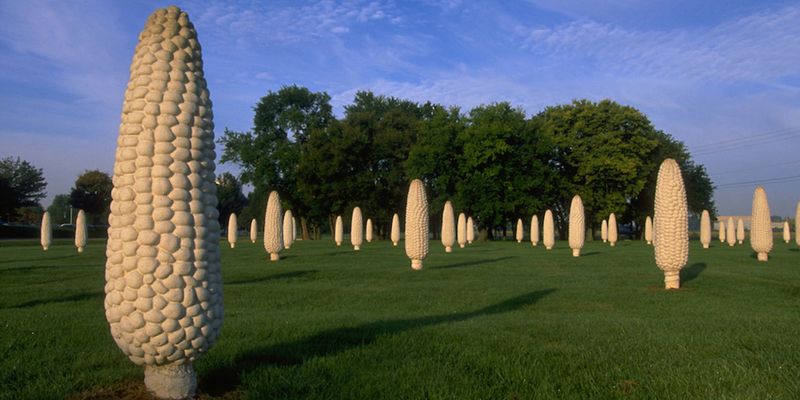In the middle of suburban Dublin, Ohio, something extraordinary rises from the ground—109 giant concrete ears of corn, each standing about six feet tall. Known affectionately as “Cornhenge,” the Field of Corn has transformed from a controversial art project into one of the most beloved and photographed landmarks in the region. What started as puzzled reactions and taxpayer grumbles has blossomed into genuine community pride, wedding backdrops, and a powerful reminder of the area’s agricultural roots.
Hidden Meanings Behind White Concrete
Cochran’s choice of stark white concrete wasn’t random—he deliberately designed the rows to echo Arlington National Cemetery’s crosses, transforming playful corn into something more profound. The installation serves as a memorial to Sam Frantz, the local farmer who partnered with Ohio State University to develop groundbreaking hybrid corn varieties right on this very land.
What residents initially dismissed as wasteful spending gradually won hearts as the sculpture became intertwined with community life. Wedding photographers discovered its photogenic qualities, while winter snowfalls transformed the field into an ethereal wonderland.
The artwork honors not just agriculture but an entire way of life—one that disappeared as housing developments and office complexes replaced working farms across central Ohio.
Where Farmland Met Suburbia
Before concrete corn sprouted here, real corn grew in neat rows tended by Sam Frantz, whose collaboration with university researchers produced varieties that changed American agriculture. Five bronze plaques scattered throughout the site tell this land’s complete story—from Native American presence through European settlement, agricultural dominance, and finally suburban transformation.
Osage orange trees dot the landscape between concrete ears, referencing the windbreaks farmers once planted to protect crops and livestock. These details root the artwork firmly in authentic agricultural tradition rather than abstract concept.
The installation captures a moment of transition happening across America—rural landscapes giving way to urban sprawl, yet leaving behind monuments that preserve agricultural memory for generations who’ll never plow a field themselves.
Birth of a Concrete Monument
Malcolm Cochran, a sculpture professor at Ohio State University, brought this unusual vision to life in 1994 after receiving a commission from the Dublin Arts Council. Using molds from just three original sculptures, he cleverly rotated each piece to create 109 unique concrete ears, ensuring no two stand at exactly the same angle.
Located at 4995 Rings Road, the installation occupies land that once functioned as a genuine working cornfield. Each towering ear reaches roughly six feet in height, creating an impressive grid that commands attention from passing motorists and curious visitors alike.
The sheer scale surprises first-time viewers—these aren’t small garden ornaments but massive concrete structures that dominate the landscape and challenge expectations about what public art can be.






